Cookie Science 14: One experiment, 400 cookies
To put the chew back in my gluten-free cookies, I’m learning from the first batches
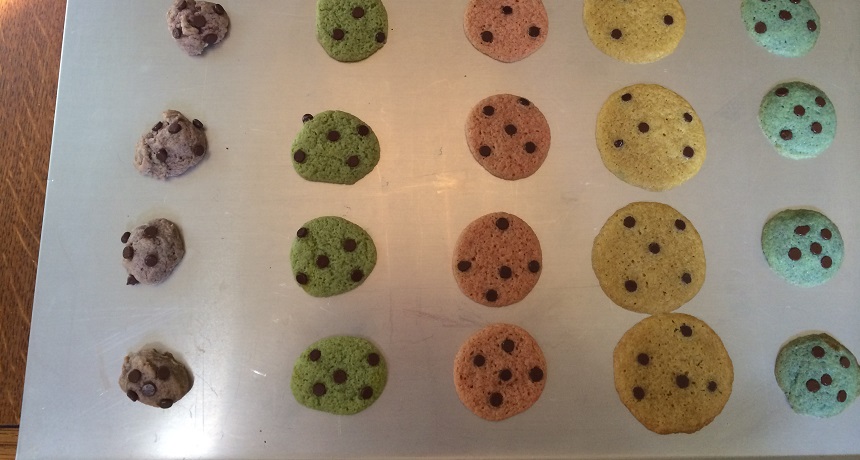
Some cookies from my second experiment. Purple cookies, left, had the highest amount of xanthan gum. Traditional, or control, cookies (far right) were colored blue.
B. Brookshire/SSP
This article is one of a series of Experiments meant to teach students about how science is done, from generating a hypothesis to designing an experiment to analyzing the results with statistics. You can repeat the steps here and compare your results — or use this as inspiration to design your own experiment.
Several friends and I recently spent more than eight hours straight in the kitchen. We weren’t making an elaborate dinner or trying out new recipes. We were doing research. It just happened to require baking more than 400 cookies.
My goal never really had been to make 400 cookies. I wanted to create just one, a treat for a friend who can’t stomach the gluten proteins found in wheat. I had recently completed one experiment comparing the taste of cookies using wheat flour to those made with gluten-free flour.
Without gluten, cookies baked up flat and lost their delicious chewiness. Now I wanted to see if I could put the chew back into those gluten-free cookies. After reading many scientific papers, I learned of a chemical that should help: xanthan gum. It’s a polymer — a molecule made of long chains of repeating groups of atoms. In this case, the long chains mean that xanthan gum can make my cookie dough more elastic.
But I don’t know how much xanthan gum to use. To find out, I need to try varying amounts in each batch of cookies. I also need to make sure the xanthan gum is the only active ingredient that changes from batch to batch. (My colorings change too, but they’re not “active” ingredients.) I also need to control — keep constant — as many of my other variables as I can. So I will bake each type of cookie at the same temperature and for the same amount of time. And each cookie will get exactly five chocolate chips, to make sure one is not more chocolatey than another.
I had a control cookie batch (all the ingredients are listed here) and a batch of cookies that used the same recipe, with gluten-free baking flour instead of wheat flour. I also had three other batches of cookies using the same gluten-free recipe. To each of these batches, I added a different amount of xanthan gum. The first had just half a teaspoon. The next had one teaspoon and the final batch had five teaspoons of xanthan gum.
Baking a bunch of batches
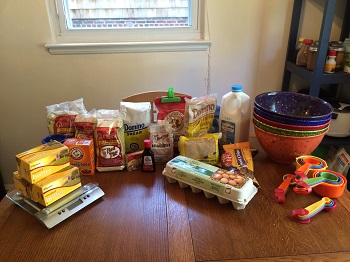
For this experiment, each volunteer would have to eat five cookies — rating the taste of each. I needed to make sure that I had enough people tasting my cookies to minimize the chance that any differences in rankings were due to chance. There’s a statistical test that can tell me how many cookie tasters I to reduce the possibility of making the wrong conclusion about my data. This test has been simplified down to a table (table 2 here).
I had five groups of cookies to compare. I wanted to make sure there was a less than five percent chance that I might “see” a difference when one didn’t really exist. The tables showed me I should be able to detect a large difference between my five cookies if at least 16 people ate them. But if any real difference were small, I’d need 240 tasters. I decided to detect a medium difference. That should need only about 39 cookie tasters. And that meant I’d need 195 cookies.
What if some people didn’t fill out their rankings correctly? What if some of the cookies fell apart? And of course, what if I got hungry and ate a few? I baked plenty of extra cookies to make sure I had enough. In the end, I got a little carried away. I made more than 400.
Just like my last experiment, I weighed out all of the ingredients carefully. I mixed in the flour, sugar, water and eggs in the same order. I cooled the dough in the fridge for the same amount of time. Also as in the earlier experiment, I added food coloring to each batch. This way, I could tell which cookie came from which batch without telling my tasters.
In the first experiment, my control cookies were red. My two gluten-free batches were blue and green. But what if people simply like red cookies more or blue cookies less? This time, I switched the colors around. My control cookie was blue and my gluten free cookie was yellow. My three xanthan gum cookie batches were red (for half a teaspoon of xanthan gum), green (one teaspoon) and purple (five teaspoons).
Baking adjustments
Based on my earlier experiment, I now knew to space my cookies out so I could bake all five types at once and on the same tray. My previous experiment also showed that gluten-free cookies spread more while baking, ending up wide and flat. So I measured the cookie dough before it went into the oven, to make sure all cookies started out with the same amount of dough. For each batch, I changed the position of the cookies on the sheet, making sure that one cookie type was not always stuck in the same place in my oven.
I also measured cookies after they baked. That way I would be able to calculate how much the xanthan gum might have changed how much the gluten-free cookie spread. I kept careful track of all of this in my lab notebook.
I couldn’t have done all of this without plenty of help from my friends. They helped me write things down, measure things out and made a whole day in the kitchen a lot of fun. Their reward: Lots of cookies to sample.
Once the cookies were baked, I put them to the test. Stay tuned to find out what I learned.


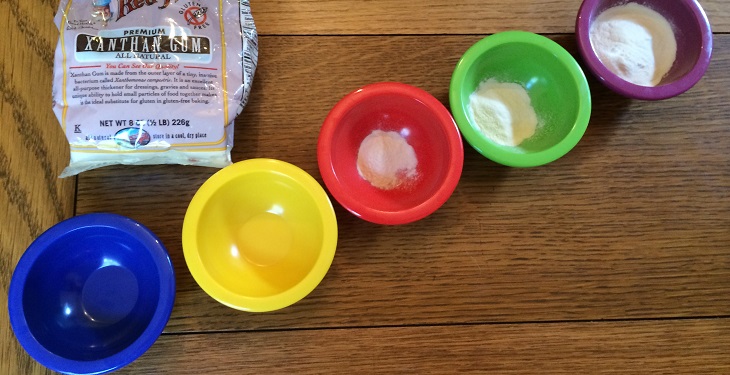
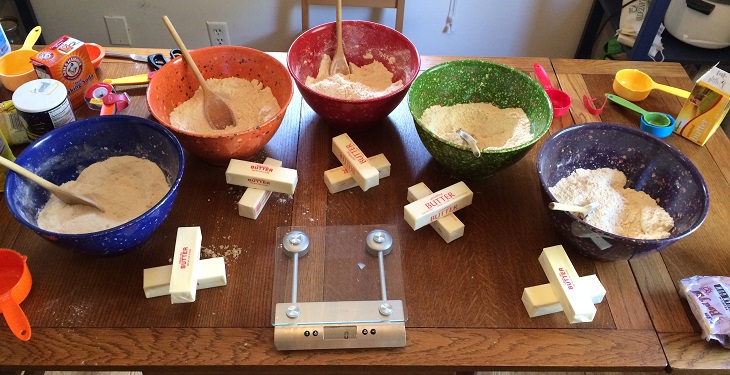
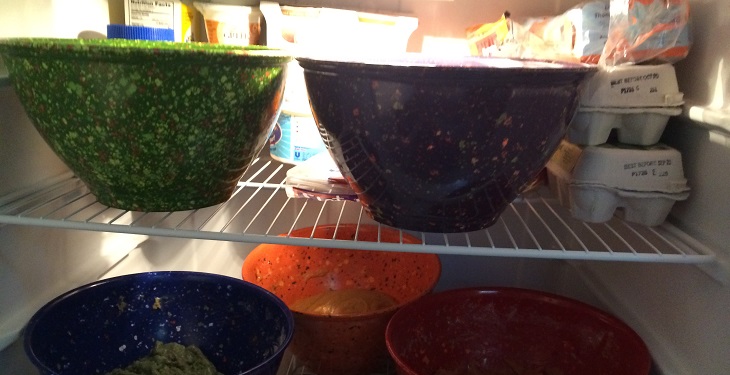
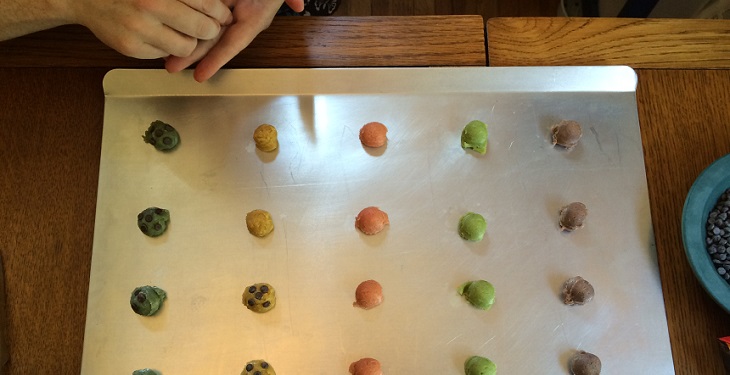
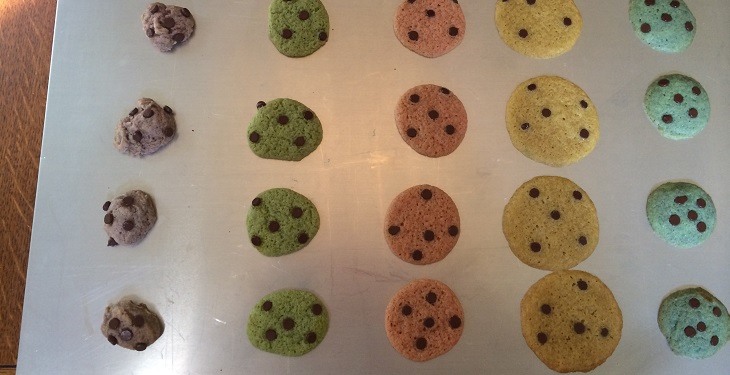

Follow Eureka! Lab on Twitter
Power Words
(for more about Power Words, click here)
atom The basic unit of a chemical element. Atoms are made up of a dense nucleus that contains positively charged protons and neutrally charged neutrons. The nucleus is orbited by a cloud of negatively charged electrons.
control A part of an experiment where there is no change from normal conditions. The control is essential to scientific experiments. It shows that any new effect is likely due only to the part of the test that a researcher has altered. For example, if scientists were testing different types of fertilizer in a garden, they would want one section of it to remain unfertilized, as the control. Its area would show how plants in this garden grow under normal conditions. And that give scientists something against which they can compare their experimental data.
gluten A pair of proteins — gliadin and glutenin — joined together and found in wheat, rye, spelt and barley. The bound proteins give bread, cake and cookie doughs their elasticity and chewiness. Some people may not be able to comfortably tolerate gluten, however, because of a gluten allergy or celiac disease.
hypothesis A proposed explanation for a phenomenon. In science, a hypothesis is an idea that hasn’t yet been rigorously tested. Once a hypothesis has been extensively tested and is generally accepted to be the accurate explanation for an observation, it becomes a scientific theory.
polymer Substances whose molecules are made of long chains of repeating groups of atoms. Manufactured polymers include nylon, polyvinyl chloride (better known as PVC) and many types of plastics. Natural polymers include rubber, silk and cellulose (found in plants and used to make paper, for example).
statistics The practice or science of collecting and analyzing numerical data in large quantities and interpreting their meaning. Much of this work involves reducing errors that might be attributable to random variation. A professional who works in this field is called a statistician.
statistical analysis A mathematical process that allows scientists to draw conclusions from a set of data.
statistical significance In research, a result is significant (from a statistical point of view) if the likelihood that an observed difference between two or more conditions would not be due to chance. Obtaining a result that is statistically significant means there is a very high likelihood that any difference that is measured was not the result of random accidents.
variable (in experiments) A factor that can be changed, especially one allowed to change in a scientific experiment. For instance, when measuring how much insecticide it might take to kill a fly, researchers might change the dose or the age at which the insect is exposed. Both the dose and age would be variables in this experiment.
xanthan gum A hydrocolloid made by the bacterium Xanthomonas campestris. It is a long-chained polymer often used in baking to make substances more elastic.